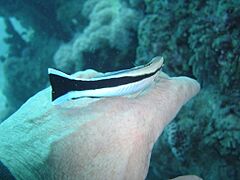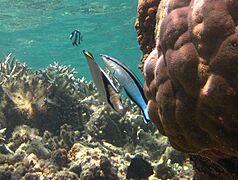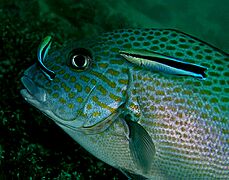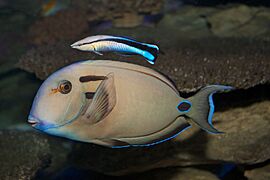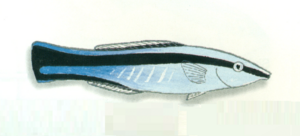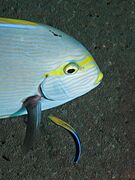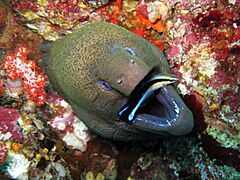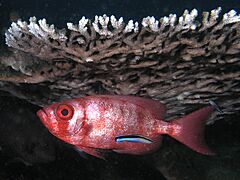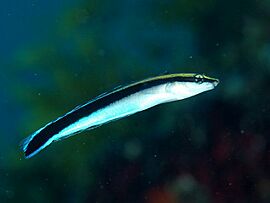Bluestreak cleaner wrasse facts for kids
Quick facts for kids Bluestreak cleaner wrasse |
|
|---|---|
 |
|
| Conservation status | |
| Scientific classification | |
| Synonyms | |
|
The bluestreak cleaner wrasse (Labroides dimidiatus) is a small, helpful fish. It lives on coral reefs in warm ocean waters. You can find it from East Africa to the Red Sea and all the way to French Polynesia. This wrasse is known for a special job. It eats tiny parasites and dead skin from bigger fish. This is a win-win deal for both fish. The wrasse gets food, and the bigger fish gets clean and healthy!
Contents
What Does It Look Like?
This wrasse is a small fish. It usually grows to about 10 centimeters (4 inches) long. The longest ones can reach 14 centimeters (5.5 inches). It's easy to spot because of its colors. It has a wide black stripe along its side and eye. Its back and belly are white, sometimes a bit yellow. The front of its body turns a bright blue. The black stripe gets wider near its tail. Young bluestreak cleaner wrasses are black with a bright electric blue line.
Where Does It Live?
The bluestreak cleaner wrasse lives on coral reefs. It prefers tropical waters. You can find it in the Red Sea and Indian Ocean. It also lives in the western Pacific Ocean. This includes places like Papua New Guinea, Japan, Fiji, and French Polynesia. In 2015, it was even seen near New Zealand. This was discovered by looking at old documentary videos.
How Does It Clean?
Bluestreak cleaner wrasses often hang out at "cleaning stations." These are like special service areas on the reef. Different groups of wrasses work at these stations. Sometimes it's a group of young fish. Other times, it's a pair of adult wrasses. Or it might be a group of females with one main male.
When a bigger fish comes near, the cleaner wrasses greet it. They do a little dance, moving their tail up and down. These bigger fish are called "clients." The wrasses clean them to eat tiny parasites from their skin. The bigger fish know these wrasses are cleaners. They recognize their stripe and their special movements.
The Cleaning Process
The cleaner wrasses greet clients to get food. When a client fish sees a cleaner, it stops. It takes a special pose to let the cleaner get to its body. The wrasse cleans its skin, gills, and sometimes even its mouth. Other fish, like some gobies, also do this cleaning job. The bluestreak cleaner wrasse cleans many types of sea animals. This includes sharks, whales, lobsters, octopuses, and sea turtles.
-
L. dimidiatus with a client surgeonfish at a cleaning station
-
Cleaner Wrasse with a client Moray eel
Fake Cleaners
Some fish pretend to be cleaner wrasses. For example, a type of blenny called Aspidontus taeniatus looks just like a cleaner wrasse. But instead of cleaning, it bites off small pieces of skin from bigger fish! Another fish, the bluestreak fangblenny, also mimics young cleaner wrasses. This way, the real cleaners let it stay close. Then, it can surprise other fish and bite them too.
Why Cleaning Matters
In some places, cleaner wrasses mostly eat parasites from clients. This helps the client fish stay healthy. Fish that get cleaned often have fewer health problems. For example, in the Ras Muhammad National Park in Egypt, wrasses clean fish like the brown surgeonfish. These cleaned fish seem to have stronger bodies. This shows how important cleaner wrasses are for the reef.
Reproduction
Male cleaner wrasses protect their living areas. They also control the females in their territory. If the main male leaves or dies, one of the larger females can change sex. This female then becomes a male and takes control of the territory.



